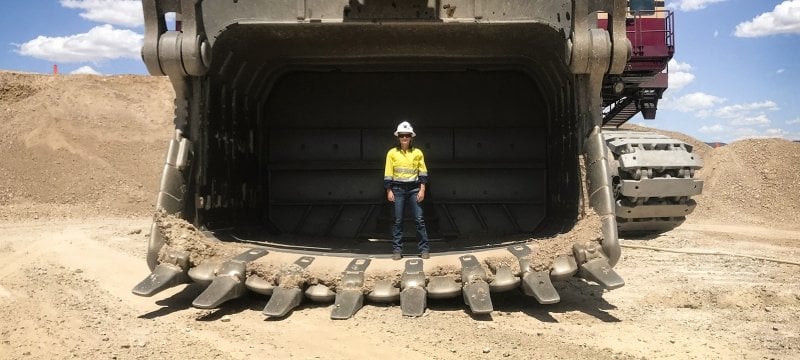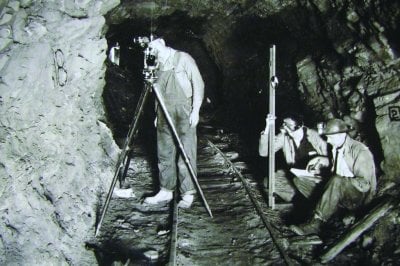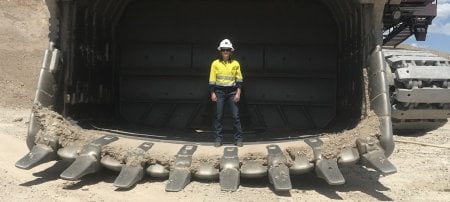In 1885, the Michigan Mining School opened its doors. Copper was booming; housing density in Calumet, Michigan, was as thick as in New York City; the Keweenaw's remote Upper Peninsula forests were clear cut and much of the timber went underground in mine shafts and drifts. The school started with 23 students—all mining engineers in training.
Much has changed in the past 134 years: Notably, mining in the Keweenaw "Copper Country" and the purpose of the mining school, renamed Michigan Technological University in 1964. But an industrialized place can never fully escape its roots, and as engineering has changed over the last century so have the practices and uses of mines. From a new but familiar degree to creative energy solutions, mining in Michigan is being reimagined and refurbished.
Bachelor of Science in Mining Engineering
Amidst development efforts to bring more mining back to Michigan, the state created a new committee to make recommendations to grow the industry. The process is not simple—we do not live in our grandparents' landscapes, neither physically or politically—and the bill's sponsor, Michigan State Representative Sara Cambensy, says the ultimate goal of the advisory committee is to "do things better." Ever ready for a challenge, engineers are the ones who bridge traditional extractive industries and modern expectations.
Robo-Intern One
Shawn vanDoorn graduates with a degree in mining engineering in May 2020. She interned with global mining companies Barrick and Freeport-McMoRan (and starts a full-time gig down in Arizona at the Safford mine next June).
"I don't want to be indoors at a desk all the time; I don't want to be in a factory the rest of my life," vanDoorn says, adding that she grew up in a logging family in northern Wisconsin and loves the outdoors. "That's what I like about mining—there's a balance of design work in the office and somedays you have to visit the dig face. Personally, I'm excited to work on the operations side because I like people and enjoy being in the mine."
She says safety and adapting to new technology are the biggest changes in mining curriculum over the past century. For example, while working in Nevada at the Goldstrike mine, vanDoorn drove P&H 4100 shovels and helped bring online some of the company's first autonomous Komatsu 930E haul trucks. Her internship title: Robo-Intern One.
Read more about vanDoorn's journey.
"Michigan Tech is bringing back its undergraduate mining engineering degree because the industry needs professional engineers who can address today's technical challenges—and to do so in an environmentally responsible manner," says John Gierke '84 '86 '90, chair of the Department of Geological and Mining Engineering and Sciences. "Sure, we're returning to our historic mission, and it's great to honor that path, but we're also reshaping how mining is done by how we will train future engineers."
The changes required in new mining endeavors focus on the front end of the work. In the past, mining operations dug deep, tossed first, and remediated later, which is a costly and wasteful process that makes environmental and human health a cheap price for fast economic gain. Best practices in mining now demand thoughtful siting, remediation strategies, community engagement, and more backup plans than an operations crew can shake a shovel at.
"The future of the mining industry is transforming in the digital age through the integration of technologies and innovations that achieve lower operational costs, improve worker safety, and reduce environmental impacts while supporting a global socio-economic system," says Snehamoy Chatterjee, assistant professor of mining engineering. "That means that our students need to understand the traditional mining engineering techniques that have dominated the industry for generations, but also be technically savvy enough to see how the newest digital innovations might fit into a better decision making or engineering design process."
Alongside people like Nathan Manser '01 '09, mining engineering lecturer, Michigan Tech faculty are inspiring students to get their hands dirty by thinking beyond traditional designs and being willing to confront the challenges that come with yesterday's waste, today's technology, and tomorrow's needs.
No matter what, mines do come at a cost—they are bound to leave an imprint on the earth. However, there are known methods to minimize that impact, which students in the mining engineering program will be steeped in, and Generation Z's hallmark is wanting to make a real difference in the world. Plus, few people are willing to give up their cars, phones, buildings, air travel, paint, and garden fertilizer. As the old PR tagline goes, if it's not grown, then it's mined.
Or perhaps there are more options.
"The future of the mining industry is transforming in the digital age."
Mines as Batteries and Heat Exchangers
Old mines can find new uses: Deep, abandoned shafts can be used for pumped hydropower energy storage. This summer, an interdisciplinary group of researchers began a pilot study in Negaunee, Michigan, to determine the feasibility of repurposing the Mather B Mine into a giant battery.
Roman Sidortsov, assistant professor of energy policy, Chelsea Schelly, associate professor of sociology, and Tim Scarlett, associate professor of archeology and anthropology, are the project leads. The team, all from the Department of Social Sciences, says the effort can help struggling post-industrial mining communities to transform decommissioned mines from environmental and economic liabilities into productive assets. Although pumped hydropower is currently the most prevalent form of energy storage worldwide, permitting new sites becomes difficult due to environmental and aesthetic concerns. Placing these systems into an existing mine takes care of the concerns and the existing mine site infrastructure can significantly reduce capital costs.
"Communities can look at the abandoned mines in their area and consider them more holistically than an energy company or utility provider might." Scarlett says. "There are many flexible design options at multiple scales, from the household or industrial park seeking energy reliability or independence, up to gigawatt- scale facilities supporting the grid reliability and resiliency for a large region of the national electrical grid."
Sidortsov adds: "With the rapid growth of renewable energy, the need for energy storage has been increasing at a neck-breaking speed. There are more than enough mines across the United States and the world that could potentially serve as sites for energy storage of different scales. More importantly, such facilities belong to the category of win-win projects as they are capable of delivering environmental, economic, and social benefits for the government, community, and industry, while achieving something that thus far has been out of reach: sustainable mining."
Within the mines, Michigan Tech faculty and students have been trying to improve ways geothermal energy is harvested from mine water. Assistant Professor of Civil and Environmental Engineering Zhen Liu and the Keweenaw Research Center's Director Jay Meldrum have led teams studying the movement of water in abandoned mines, as variations in temperature and salinity cause complex flow patterns in old, flooded workings. Modeling this complicated mixing process is the central challenge to designing systems that maximize the value of harvested geothermal energy.
To that end, Michigan Tech installed a model geothermal system at the Keweenaw Research Center 10 years ago, which has been a model for ongoing research and education, and more recently inspired community discussions on the social acceptability of a mine water geothermal energy system in Calumet, Michigan. Led by Richelle Winkler, associate professor of sociology, a group of student researchers also put together the first comprehensive guidebook communities can use to explore the feasibility of using mine water to heat and cool buildings.
More Than a Mine
Mining techniques learned in Michigan reach beyond the state. The lessons learned here may help astronauts get back from Mars—research being explored by mechanical engineer Paul van Susante by producing rocket propellant from gypsum rock on Mars. Or help reduce coal dust in mines around the world and inspire new ways to use old technology to recycle lithium batteries—projects led by chemical engineer Lei Pan. Tim Eisele '84 '87 '92, associate professor of chemical engineering, sees other opportunities in mining technology, specifically waste products.
"The technology for separating valuable minerals from mined material is always improving, and so there is much opportunity for reprocessing former tailings materials," Eisele says. "This material is already mined, crushed to a fine size, and stored accessibly on the surface, so there is a lot of room for recovering metal that it was not formerly economical to extract."
He adds there are ore bodies that used to be considered too low-grade to work with, but that now could potentially be mined safely and economically. For example, there are new processes in the works to source materials that Michigan mining has historically concentrated on, like cement, clays, copper, iron, limestone, gypsum, salt, and sand/gravel.
There is also the attraction of developing markets for all of the minerals mined, not just the key mineral. If in addition to selling metal ore concentrates, a mine can also sell other products like aggregates, agricultural supplements, and byproduct industrial minerals, then the quantity of remaining tailings can be reduced while also increasing profitability.
"To do this, we need a much better understanding of what is actually being mined and who might potentially want to buy it," Eisele says. "In a perfect mining operation, all of the minerals dug out of a mine would eventually be converted into useful products and the mine tailings would become nonexistent."
Michigan's mines, old and new, aren't going away. To break boom-bust cycles, it takes collaborative and creative thinking to delve beyond what mining used to be and reengineer the training, tools, and spaces to meet the needs of modern extraction and consumption.
Michigan Technological University is an R1 public research university founded in 1885 in Houghton, and is home to nearly 7,500 students from more than 60 countries around the world. Consistently ranked among the best universities in the country for return on investment, Michigan's flagship technological university offers more than 185 undergraduate and graduate degree programs in science and technology, engineering, computing, forestry, business, health professions, humanities, mathematics, social sciences, and the arts. The rural campus is situated just miles from Lake Superior in Michigan's Upper Peninsula, offering year-round opportunities for outdoor adventure.






